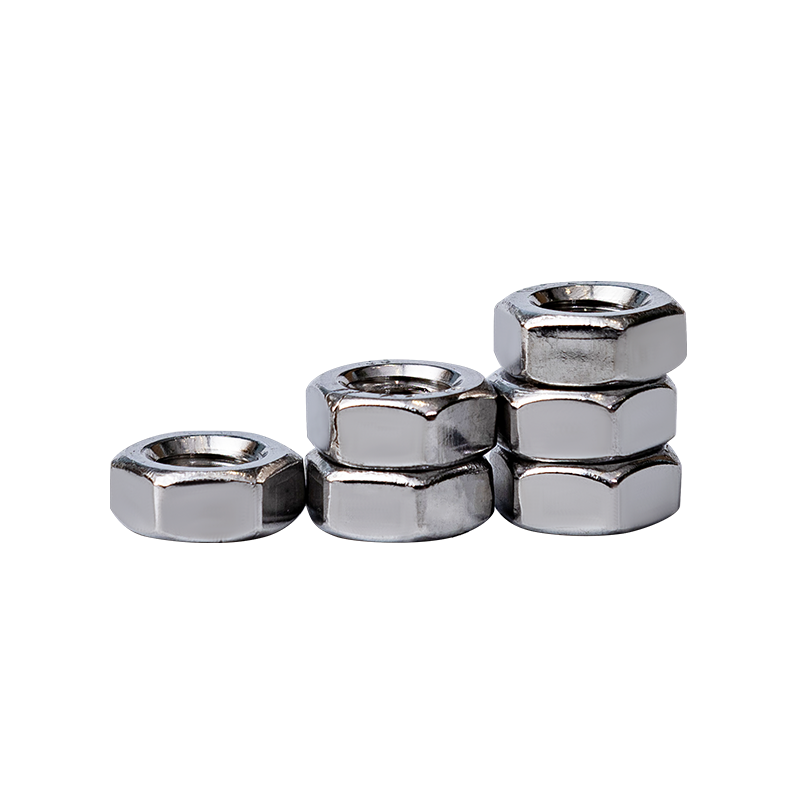Stainless steel hex nuts are widely used in various industries due to their excellent mechanical properties and notably strong corrosion resistance. Corrosion resistance is one of the most critical features that make stainless steel fasteners highly desirable, especially in harsh environments where ordinary steel would quickly degrade. This article explores the factors that contribute to the corrosion resistance of stainless steel hex nuts, the types of stainless steel commonly used, how they perform in different environments, and best practices to maximize their longevity.
1. What Makes Stainless Steel CorrosionResistant?
The corrosion resistance of stainless steel primarily comes from the presence of chromium in its composition. Chromium reacts with oxygen in the environment to form a very thin, stable, and invisible layer of chromium oxide on the surface of the steel. This oxide layer acts as a protective barrier, preventing further oxygen and moisture from reaching the underlying metal and causing rust or corrosion.
This layer is selfhealing, which means if it gets scratched or damaged, it can quickly reform in the presence of oxygen, maintaining continuous protection over time. This characteristic sets stainless steel apart from ordinary carbon steel, which lacks this protective oxide film and therefore corrodes easily when exposed to moisture or corrosive substances.
2. Common Stainless Steel Grades for Hex Nuts
Not all stainless steel grades offer the same level of corrosion resistance. The two most commonly used grades for stainless steel hex nuts are:
304 Stainless Steel: This is the most widely used stainless steel grade. It contains about 1820% chromium and 810.5% nickel. It offers excellent corrosion resistance in normal atmospheric conditions, including resistance to many acids and alkalis. However, it is less resistant to chlorideinduced corrosion (such as saltwater environments).
316 Stainless Steel: Known as marinegrade stainless steel, 316 contains molybdenum (23%), which significantly enhances its resistance to chlorides and saline environments. This makes 316 stainless steel hex nuts ideal for use in coastal, marine, and chemical processing environments where exposure to salt or harsh chemicals is common.
Other specialized grades exist, but 304 and 316 cover the majority of typical applications requiring corrosion resistance.
3. Corrosion Resistance in Different Environments
The performance of stainless steel hex nuts varies depending on the environment:
Atmospheric Conditions: In clean, dry air or mildly polluted environments, stainless steel hex nuts, especially grade 304, perform exceptionally well with minimal signs of rust or pitting even after many years.
Marine Environments: Due to the presence of salt, marine environments are highly corrosive. Here, 316 stainless steel hex nuts are preferred because their molybdenum content provides extra protection against pitting and crevice corrosion caused by chlorides.
Industrial and Chemical Environments: Exposure to acids, alkalis, and various chemicals can degrade many materials. Stainless steel hex nuts, particularly grades with enhanced corrosion resistance, can withstand many of these aggressive substances, but the exact grade must be selected based on the specific chemical exposure.
HighTemperature Environments: Stainless steel can also resist oxidation and corrosion at elevated temperatures, but the grade and alloying elements impact performance. For example, some stainless steels with higher chromium and nickel content are used in heatresistant fasteners.
4. Common Types of Corrosion Affecting Stainless Steel Hex Nuts
Even stainless steel can corrode under certain conditions. The most common types include:
Pitting Corrosion: Small, localized holes or “pits” can develop when the protective oxide film breaks down in chloriderich environments. This is why 316 stainless steel is preferred for salty or marine settings.
Crevice Corrosion: Occurs in confined spaces where oxygen cannot easily reach, such as under washers or between threads. Proper design and installation can minimize crevice corrosion.
Galvanic Corrosion: Happens when stainless steel is in electrical contact with a different metal in a corrosive environment, creating a galvanic cell. Using compatible materials and insulating fasteners can prevent this.
Stress Corrosion Cracking (SCC): A combination of tensile stress and corrosive environment can cause cracking. This is rare but important to consider in critical applications.
5. Factors Influencing Corrosion Resistance
Several factors influence how well stainless steel hex nuts resist corrosion:
Alloy Composition: As noted, chromium, nickel, and molybdenum content are key.
Surface Finish: Polished or passivated surfaces have better corrosion resistance than rough or scratched surfaces. Passivation is a chemical treatment that enhances the protective oxide layer.
Maintenance and Cleaning: Regular cleaning to remove contaminants like salt, dirt, or chemicals helps maintain corrosion resistance.
Proper Installation: Avoiding overtightening, using compatible washers, and ensuring proper torque can prevent damage that exposes the base metal to corrosion.
6. Enhancing Corrosion Resistance
To further enhance corrosion resistance, manufacturers often:
Apply Surface Treatments: Passivation and electropolishing remove free iron and improve the chromium oxide layer.
Use Coatings: Sometimes hex nuts are coated with anticorrosion layers for extreme environments.
Select Appropriate Grades: Choosing highergrade stainless steel or specialized alloys for demanding conditions.
The corrosion resistance of stainless steel hex nuts is one of their standout features, making them ideal for use in environments where durability and longevity are critical. Their inherent protective chromium oxide layer shields them from rust and degradation, especially when the appropriate stainless steel grade is selected. Understanding the environment and corrosion types helps in choosing the right material and maintenance practices, ensuring the hex nuts maintain their strength and appearance over time.




 русский
русский Español
Español عربى
عربى italiano
italiano
 No. 2 Bridge, Chuangxin Road, Dainan Town, Xinghua City, Taizhou City, Jiangsu Province
No. 2 Bridge, Chuangxin Road, Dainan Town, Xinghua City, Taizhou City, Jiangsu Province  +86-17315333748(Wechat)
+86-17315333748(Wechat)
 +86-17315333748(Wechat/Whatsapp)
+86-17315333748(Wechat/Whatsapp)

